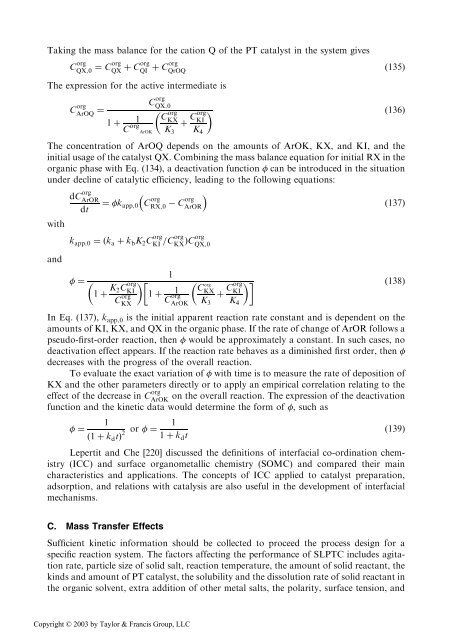11. Interfacial Mechanism and Kinetics of Phase-Transfer Catalysis
11. Interfacial Mechanism and Kinetics of Phase-Transfer Catalysis
11. Interfacial Mechanism and Kinetics of Phase-Transfer Catalysis
You also want an ePaper? Increase the reach of your titles
YUMPU automatically turns print PDFs into web optimized ePapers that Google loves.
Taking the mass balance for the cation Q <strong>of</strong> the PT catalyst in the system givesC orgQX;0 ¼ Corg QX þ Corg QI þ Corg QrOQThe expression for the active intermediate isC orgArOQ ¼1 þ 1C org ArOKC orgQX;0C orgKXþ Corg KIK 3 K 4ð135Þ ð136ÞThe concentration <strong>of</strong> ArOQ depends on the amounts <strong>of</strong> ArOK, KX, <strong>and</strong> KI, <strong>and</strong> theinitial usage <strong>of</strong> the catalyst QX. Combining the mass balance equation for initial RX in theorganic phase with Eq. (134), a deactivation function can be introduced in the situationunder decline <strong>of</strong> catalytic efficiency, leading to the following equations:withdC orgArORdt¼ k app;0C orgRX;0C orgArORk app;0 ¼ðk a þ k b K 2 C orgKI =Corg KX ÞCorg QX;0ð137Þ<strong>and</strong>1 ¼ 1 þ K 2C org ð138ÞKIC org 1 þ 1 C orgKXC org KXþ Corg KIArOK K 3 K 4In Eq. (137), k app;0 is the initial apparent reaction rate constant <strong>and</strong> is dependent on theamounts <strong>of</strong> KI, KX, <strong>and</strong> QX in the organic phase. If the rate <strong>of</strong> change <strong>of</strong> ArOR follows apseudo-first-order reaction, then would be approximately a constant. In such cases, nodeactivation effect appears. If the reaction rate behaves as a diminished first order, then decreases with the progress <strong>of</strong> the overall reaction.To evaluate the exact variation <strong>of</strong> with time is to measure the rate <strong>of</strong> deposition <strong>of</strong>KX <strong>and</strong> the other parameters directly or to apply an empirical correlation relating to theeffect <strong>of</strong> the decrease in C orgArOKon the overall reaction. The expression <strong>of</strong> the deactivationfunction <strong>and</strong> the kinetic data would determine the form <strong>of</strong> , such as1 ¼ð1 þ k d tÞ 2 or ¼ 1ð139Þ1 þ k d tLepertit <strong>and</strong> Che [220] discussed the definitions <strong>of</strong> interfacial co-ordination chemistry(ICC) <strong>and</strong> surface organometallic chemistry (SOMC) <strong>and</strong> compared their maincharacteristics <strong>and</strong> applications. The concepts <strong>of</strong> ICC applied to catalyst preparation,adsorption, <strong>and</strong> relations with catalysis are also useful in the development <strong>of</strong> interfacialmechanisms.C. Mass <strong>Transfer</strong> EffectsSufficient kinetic information should be collected to proceed the process design for aspecific reaction system. The factors affecting the performance <strong>of</strong> SLPTC includes agitationrate, particle size <strong>of</strong> solid salt, reaction temperature, the amount <strong>of</strong> solid reactant, thekinds <strong>and</strong> amount <strong>of</strong> PT catalyst, the solubility <strong>and</strong> the dissolution rate <strong>of</strong> solid reactant inthe organic solvent, extra addition <strong>of</strong> other metal salts, the polarity, surface tension, <strong>and</strong>Copyright © 2003 by Taylor & Francis Group, LLC
















